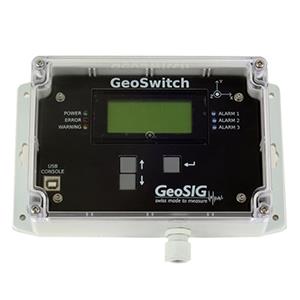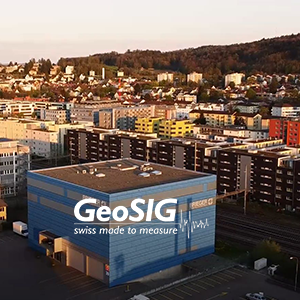GeoSIG GMS-24
Key Features
- Based on netquakes recorder
- Internet Enabled, Optionally Wireless, Multifunctional Measuring System
- 24 Bit ADC, > 140 dB, 32 Bit output word length
- 3 or 6 channels, up to 500 sps
- Linux Operating System with On Board Processing and Evaluation
- Timing via NTP (Network Time Protocol), Optional GPS or 433 MHz Wi-SynchEnhanced Connectivity Options for GSM, GPRS, Satellite, Radio Telemetry or Landline Modem, Wired/Wireless Network
- Ring Buffer Continuous Recording
- Data Stream Output, Network Triggering
- Rugged, Water Resistant Cast Aluminium Housing with Levelling Base Plate for easy installation and Replacement
The GMS-24 was the ground breaking second generation of the NetQuakes / GeoSIG Measuring Systems with extended connectivity capability and flexibility, newly in 24 Bit, reaching a dynamic range of more than 140 dB. It included an Ethernet connection and optionally a 2.4 GHz Wi-Fi module to ensure fast and reliable data transfer. Its design and efficiency made it the first choice for any application requiring seismic instruments. With its optimised installation, operation and maintenance philosophy, the GMS offered the real possibility to implement such as high density arrays with total operating costs at a small fraction of conventional strong-motion seismograph networks.
The instrument’s software processed data in real time. If triggered by a seismic event, GMS calculated Peak Ground Acceleration (PGA), Peak Ground Velocity (PGV), Peak Ground Displacement (PGD) and Response Spectrum (RSA) at various frequencies of the event. GMS could report these parameters, which are related to the strength of shaking, to a data centre where a synopsis (such as a shakemap) for disaster management facilities could be generated in almost real time over the Internet. An event file was also recorded in the memory, which was sent out from the instrument and also securely accessible over the Internet.
GMS-24 was self-contained and was equipped with an uninterruptible power-supply, which provided, excluding options, more than 24 hours emergency operation without external power. Since the battery and power management are critical components in applications, excessive care had been taken in the charger design. The GMS-24 used an intelligent “Real Time Clock” (RTC) with self-learning temperature compensation at a fraction of power and thus cost of a TCXO. The RTC was able to synchronize with GPS or NTP (Network Time Protocol based on Internet UTC timing) to provide high timing accuracy.
The instrument could be locally connected to a laptop through its ports for configuration, testing or data retrieval. The internal memory card could also be simply exchanged to retrieve the data. Several advanced communication options existed, such as for connection over the Internet; it could utilise a list of servers where the communication was based on a simple but highly secure file exchange. Wired or Wireless Interconnected Network option enabled the use of several units together in a time and trigger synchronised manner, wireless using the Wi-Fi and Wi-Synch options.
The instrument’s software processed data in real time. If triggered by a seismic event, GMS calculated Peak Ground Acceleration (PGA), Peak Ground Velocity (PGV), Peak Ground Displacement (PGD) and Response Spectrum (RSA) at various frequencies of the event. GMS could report these parameters, which are related to the strength of shaking, to a data centre where a synopsis (such as a shakemap) for disaster management facilities could be generated in almost real time over the Internet. An event file was also recorded in the memory, which was sent out from the instrument and also securely accessible over the Internet.
GMS-24 was self-contained and was equipped with an uninterruptible power-supply, which provided, excluding options, more than 24 hours emergency operation without external power. Since the battery and power management are critical components in applications, excessive care had been taken in the charger design. The GMS-24 used an intelligent “Real Time Clock” (RTC) with self-learning temperature compensation at a fraction of power and thus cost of a TCXO. The RTC was able to synchronize with GPS or NTP (Network Time Protocol based on Internet UTC timing) to provide high timing accuracy.
The instrument could be locally connected to a laptop through its ports for configuration, testing or data retrieval. The internal memory card could also be simply exchanged to retrieve the data. Several advanced communication options existed, such as for connection over the Internet; it could utilise a list of servers where the communication was based on a simple but highly secure file exchange. Wired or Wireless Interconnected Network option enabled the use of several units together in a time and trigger synchronised manner, wireless using the Wi-Fi and Wi-Synch options.
































